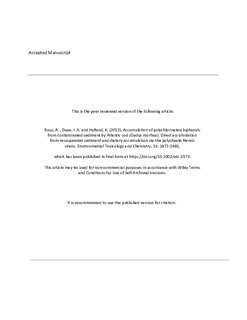| dc.contributor.author | Ruus, Anders | |
| dc.contributor.author | Daae, Ingrid Aarre | |
| dc.contributor.author | Hylland, Ketil | |
| dc.date.accessioned | 2018-10-31T13:32:51Z | |
| dc.date.available | 2018-10-31T13:32:51Z | |
| dc.date.created | 2014-11-02T14:34:54Z | |
| dc.date.issued | 2012 | |
| dc.identifier.citation | Environmental Toxicology and Chemistry. 2012, 31 (11), 2472-2481. | nb_NO |
| dc.identifier.issn | 0730-7268 | |
| dc.identifier.uri | http://hdl.handle.net/11250/2570419 | |
| dc.description.abstract | Bioaccumulation of sediment‐associated polychlorinated biphenyls (PCBs) was examined in Atlantic cod (Gadus morhua) through direct diffusion from the sediment (via the water phase) and through the food chain (dietary exposure). To facilitate direct accumulation from the sediment, it was continuously resuspended. To study the dietary bioaccumulation of PCBs, cod were fed benthic polychaetes (Nereis virens) previously exposed to test sediments, which were naturally polluted sediments from the inner Oslofjord (Norway). Both exposure experiments had a duration of 129 d. Furthermore, the role of sediments as a source of PCBs accumulated in Oslofjord cod was elucidated, using results from environmental monitoring as a reference. Generally, the results suggest that the contaminated sediments of the inner Oslofjord are an important source of legacy PCBs for accumulation in resident cod, although additional contributions may also be important. Crude estimates of assimilation efficiency of ingested PCBs (through diet) were found to be 30 to 50%; the highest was for the lower chlorinated congeners (PCB‐28 and ‐52). Challenges for applying trophic magnification factors for determining biomagnification in laboratory experiments, in terms of preventive environmental safety, are indicated. The results provide useful information for parameterization of models describing the behavior of hydrophobic persistent contaminants in the foodweb of the Oslofjord and elsewhere. | nb_NO |
| dc.language.iso | eng | nb_NO |
| dc.publisher | Wiley | nb_NO |
| dc.title | Accumulation of polychlorinated biphenyls from contaminated sediment by Atlantic cod (Gadus morhua): Direct accumulation from resuspended sediment and dietary accumulation via the polychaete Nereis virens | nb_NO |
| dc.type | Journal article | nb_NO |
| dc.type | Peer reviewed | nb_NO |
| dc.description.version | acceptedVersion | nb_NO |
| dc.source.pagenumber | 2472-2481 | nb_NO |
| dc.source.volume | 31 | nb_NO |
| dc.source.journal | Environmental Toxicology and Chemistry | nb_NO |
| dc.source.issue | 11 | nb_NO |
| dc.identifier.doi | 10.1002/etc.1973 | |
| dc.identifier.cristin | 1169066 | |
| dc.relation.project | Andre: Fagrådet, vann- og avløpsteknisk samarbeid i Indre Oslofjord | nb_NO |
| cristin.unitcode | 7464,20,13,0 | |
| cristin.unitname | Økotoksikologi | |
| cristin.ispublished | true | |
| cristin.fulltext | postprint | |
| cristin.qualitycode | 2 | |
